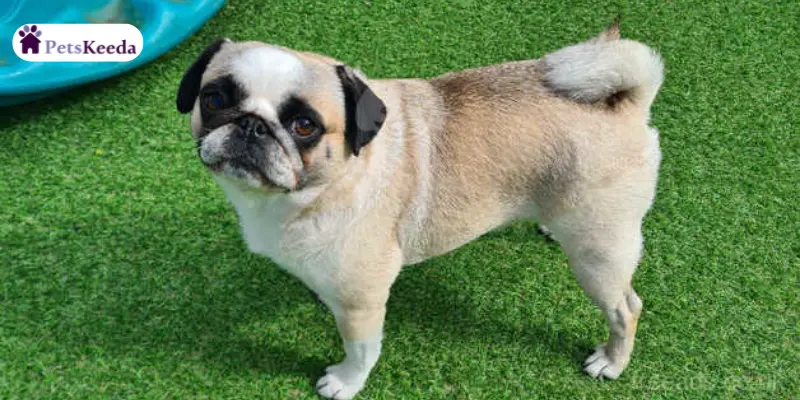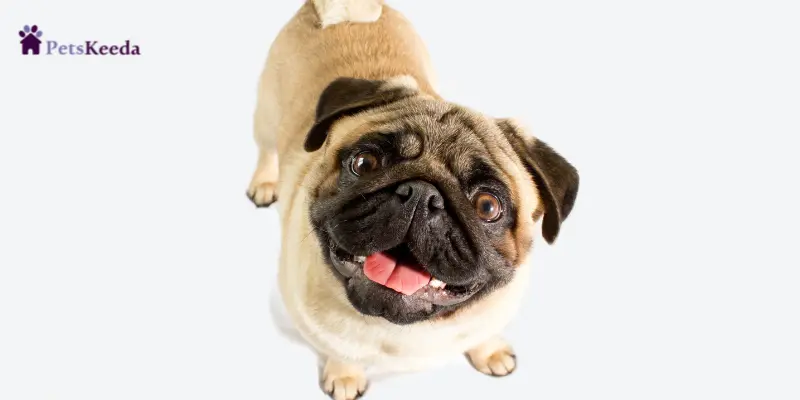Table of Contents
Panda pugs are one of the most loved but rare dog breeds in the United States. They are famous among dog enthusiasts for their friendly and affectionate nature. If you are looking for a comprehensive guide to discover everything you need to know about this dog while owning them, then you have come to the right place.
Panda Pugs are not purebred pugs because they are the result of cross-breeding pure Pugs with other small dog breeds like spaniels. They are not easily available, so you have to do a proper search to find Panda Pug Puppies.
Panda Pugs are unique and famous for their panda-like appearance. This blog will explore facts, personality, origin, history, unique facts and formal recognition of Panda Pugs so let’s dive directly into the details.
What Is a Panda Pug?
Pugs have been famous for years due to their compact, muscular build and energetic nature. But the “Panda Pugs” have started gaining attention in the past few years. They are stealing the hearts of dog enthusiasts due to their panda-like appearance and wrinkled faces. Although they are rare this has nothing to do with their fan following. To get this striking color combination, breeders have done selective breeding in the past.
| Height | 10-14 Inches |
| Weight | 14-18 Pounds |
| Type | Non-sporting |
| Lifespan | 12-15 Years |
| Area of origin | China |
History and Origin
In the 1990s, a breeder in China bred the small pug with the small dog breed Tibetan Spaniel to create Panda Pugs. The purpose of this cross-breeding was to create a striking pug with a panda-like appearance by suspecting black and white fur in offspring. Although they succeeded in their breeding goals but could not succeed in making the panda pugs, the standard breeds. Although several Kennel clubs, including the American Kennel Club(AKC), do not accept this breed, Panda Pugs have gained popularity due to their affectionate, gentle, and playful nature. Panda Pugs originated in China and are now famous worldwide.

How Panda Pugs Gained Popularity
Panda Pugs, with their black and white coat resembling panda, are an amazing hit on social media because of their cuteness and playful antics. Their friendly, affectionate nature, similar to traditional pugs, has made them a highly demanded companion pet, appealing to a varied customer base of pet owners. Social media, glorifying the tendency to keep and flaunt exotic and good-looking pets, were among the major contributors to the rise in the number and popularity of panda pugs.
These dogs adapt well to all living conditions: city or suburban. Their apparent appearance in dog shows and pet events only stokes the public, so their discerning breeding processes are scrutinized for that panda-like look. Their popularity draws much-needed attention to the changes in the desires of modern pet owners. It emphasizes that they sought companions in loving and loyal Pugs and an equally companionable and aesthetic pet.
Also Read: Apricot Pug – History & Facts with Pictures
Formal Recognition of Panda Pugs
Panda Pugs, although popular, are not accepted by the official authorities like kennel clubs. American Kennel Club (AKC) also does not accept this breed because of various valid reasons. American Kennel Club (AKC) only accepts those breeds that have a strong historical background and are purebreds but Panda Pugs are not purebreds. AKC accepts those breeds which have been stable for many years with minimum genetic defects but Panda Pugs are probably new breeds. Breeders are trying to get them accepted.

Panda Pug Nutrition
A proper diet is essential for the health and lifespan of a Pug Panda. They should be fed a balanced diet suitable for small breeds, with sufficient food to maintain a healthy weight. High-quality commercial dog food, formulated for their age, size, and activity level, is generally recommended. Avoid overfeeding and provide treats sparingly to prevent obesity, a common issue in Pugs. Freshwater should always be available. Consult a veterinarian for specific dietary recommendations, especially if your Panda Pug has special health needs or nutritional sensitivities.
How Often Should I Groom My Panda Pug?
Panda Pugs require regular grooming to maintain their coat and overall health. Their short fur should be brushed at least once a week to remove loose hairs and distribute skin oils. During shedding seasons, more frequent brushing may be necessary. Bathing can be done every few months or as needed, but it’s crucial not to over-bathe as it can dry out their skin. Pay special attention to cleaning their facial wrinkles to prevent infection and irritation. Regular nail cutting, ear cleaning, and dental care are essential to their grooming routine.
Panda Pugs Health Issues
Like standard Pugs, Panda Pugs can be prone to specific health issues. These may include brachycephalic syndrome (due to their short snouts), eye problems, skin infections in their wrinkles, and joint issues such as hip dysplasia. Obesity is a common issue, and it may cause other health problems. Regular medical checkups and a good lifestyle are essential in detecting health problems and treating your Pug; eating balanced food is necessary to maintain their average body weight.
Training a Panda Pug
Training a Panda Pug needs patience, consistency, and positive rewards. They react positively to moderate, reward-based training tactics. Start training early, focusing on essential obedience and interacting with others. Use snacks, praise, and toys to encourage and reward positive behavior. They can be stubborn sometimes, so your training approach must be firm yet gentle. Short, engaging training sessions are more effective, as they can have short attention spans.
How Much Exercise Does a Panda Pug Need?
Because of their short noses, they should not be too exercised, especially in hot or humid conditions. Mental stimulation is also necessary, so include activities that challenge their thinking. Regular exercise helps prevent obesity and keeps them both mentally and physically active.
Characteristics
Panda Pugs have the attractive qualities of classic Pugs. They are little, muscular dogs with a cute, wrinkled face and expressive eyes. This dog’s most significant distinguishing behavior is its hair color, which is the same as a panda bear’s black-and-white color. This unique color pattern makes them look different from normal Pugs, and due to these qualities, Panda Pugs are more expensive than normal Pugs.
Facts about Panda Pug
1. Distinctive Coat Color: The most striking feature of the Panda Pug is its unique coat color, which resembles the black and white pattern of a panda bear. This dog’s unusual look differentiates it from the standard white or black coat colors seen in Pugs.
2. Selective Breeding: The Panda Pug is not a naturally occurring breed but a result of selective breeding practices. Breeders especially tried to develop a Pug with a panda-like shade, keeping the Pug’s physical and behavioral features while introducing the unique black and white coat pattern.
3. Rare and Unique: Panda Pugs are a rare variation of the Pug breed due to their specific breeding and distinctive appearance. They are rare and attractive simultaneously, making them a popular choice for Pug fans considering having such a wonderful friend.

Do Panda Pugs Make Good Companions?
Yes, Panda Pugs are good companion dogs and can make excellent pets. They love to play with their owners and always love being surrounded by human beings. Panda Pugs are adaptable, so there is no need to worry if you live in an apartment; they just need a small space.
But sometimes, it becomes difficult to handle them because they demand constant attention and love. If you don’t have too much time to give your pet, the Panda Pugs are not a suitable option for you because they can develop anxiety if ignored even for 1-2 days.
Moreover, Panda Pugs are not purebreds and due to flat faces and short height, they can develop certain diseases like Brachycephalic Syndrome and Hip Dysplasia. Thus, losing your pet can cause emotional stress.
Frequently Asked Questions
Q1: What is a Panda Pug?
Ans: A Panda Pug is a Pug with distinctive black and white coloring resembling a panda.
Q2: How much does a Panda Pug puppy cost?
Ans: Prices can vary but are generally higher than standard Pugs due to their rarity.
Q3: Are Panda Pugs good with children?
Ans: Yes, they are known to be affectionate and gentle with children.
Q4: Do Panda Pugs have any special care requirements?
Ans: Aside from regular grooming and wrinkle care, their needs are similar to those of standard Pugs.
Q5: Can Panda Pugs live in apartments?
Ans: Their small size and moderate energy levels make them suitable for apartment living.
Conclusion
The Panda Pug is an exceptional and cute kind of Pug dog. They have a great personality and look very charming. They are ideal for families looking for a pet that offers much love. If you get a Panda Pug puppy, you’ll have a pet that is always excited and faithful. They will fill your home with happiness and fun. These dogs are great because they are friendly and full of energy.
Panda pugs like to play with people, especially children, making them wonderful family pets. They will also be very loyal to you and stay close to you. But, like all dogs, Panda Pugs need you to take good care of them. They need the right food, exercise, and playtime. They also need to go to the vet to stay healthy. They need your love and time to grow up well.

